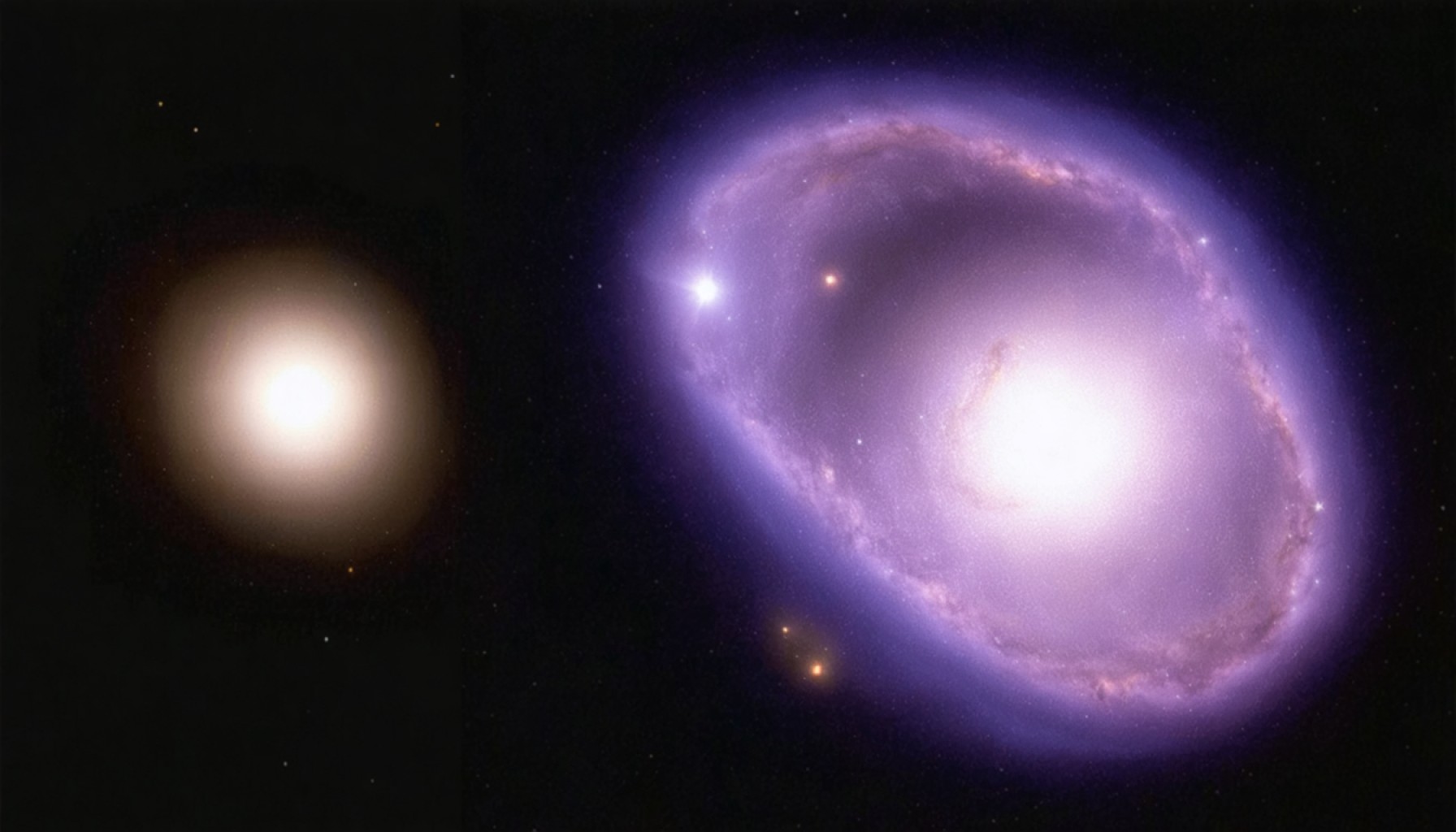- Oxygen discovered in JADES-GS-z14-0, a galaxy 13.4 billion light-years away.
- The finding reflects the universe’s state when it was just 2% of its current age.
- ALMA’s instruments in Chile detected signals indicating the presence of oxygen.
- This challenges traditional models that viewed early galaxies as simple and primarily composed of hydrogen and helium.
- The oxygen’s presence suggests rapid galaxy evolution during the universe’s infancy.
- Precise galaxy redshift refined to a 0.005% margin, demonstrating advanced measurement techniques.
- Collaboration between ALMA and the James Webb Space Telescope highlighted.
- This discovery urges reevaluation of assumptions about early cosmic development.
- JADES-GS-z14-0 adds to our evolving understanding of the universe’s beginnings.
Beneath the vast, enigmatic canopy of the universe, a remarkable find has stirred the astronomical community—oxygen in JADES-GS-z14-0, a galaxy that’s a staggering 13.4 billion light-years away. This discovery takes us back to when the universe was merely 2% of its current age, offering an unexpected glimpse into the past.
In the arid expanses of Chile’s Atacama Desert, the Atacama Large Millimeter/submillimeter Array (ALMA) captured this cosmic marvel. As its sensitive instruments dissected faint signals from the distant galaxy, oxygen emerged as the key to reshaping our understanding of the universe’s formative years.
It’s as if we’ve stumbled upon an adolescent locked in a nursery—a galaxy teeming with complexity and heavy elements in a cosmos barely 300 million years old. Traditional models of galactic evolution, which painted this era in simpler strokes of hydrogen and helium, are being vigorously reevaluated. The unexpected presence of oxygen suggests that galaxies like JADES-GS-z14-0 evolved rapidly, challenging the long-standing assumptions held by astronomers.
This revelation extends beyond the heavy elements. Pinpointing the galaxy’s distance with heretofore unseen precision, the oxygen detection refined the galaxy’s redshift to a razor-thin margin of 0.005%. The teamwork between ALMA and the James Webb Space Telescope exemplifies the harmonious dance of technology and discovery.
The narrative this distant galaxy tells is not just one of early maturation, but also a reminder that our cosmic understanding is still unfolding. Each observation paints the universe with broader and bolder strokes, urging us to question and explore.
In the grand theater above us, JADES-GS-z14-0 stands as both a relic and a revelation, whispering tales from the infancy of everything we know. While mysteries linger in the folds of the cosmos, this discovery signals that the beginnings of galaxies—and indeed, our universe—were far more dynamic than previously imagined. The stars began their stories far earlier, and their narratives may hold secrets yet uncovered.
Unveiling Cosmic Mysteries: The Stunning Discovery of Ancient Oxygen in a Distant Galaxy
Understanding the Implications of Oxygen in JADES-GS-z14-0
The discovery of oxygen in the JADES-GS-z14-0 galaxy, located 13.4 billion light-years away, is a groundbreaking event in astronomy, pointing towards the rapid evolution of galaxies in the early universe. This finding challenges the established models of galactic formation, which largely focused on simpler elements like hydrogen and helium existing during the universe’s infancy.
Why is this Discovery Significant?
1. Revised Galactic Evolution Models: The detection of oxygen, an element heavier than hydrogen or helium, in such a primitive galaxy suggests that nuclear synthesis processes were already active in stars, creating heavy elements far sooner than theorized.
2. Technological Harmonization: The collaboration between the Atacama Large Millimeter/submillimeter Array (ALMA) and the James Webb Space Telescope exemplifies technological advancements in astronomy, refining our ability to pinpoint cosmic distances with unprecedented accuracy.
3. Cosmic Timelines: This discovery reshapes our understanding of timelines for star and galaxy formation, suggesting that these processes were in full swing even when the universe was only 300 million years old—a mere 2% of its current age.
Real-World Use Cases and Industry Impacts
– Astrophysics and Research: The revised models impact ongoing research in astrophysics, as scientists must now consider the rapid formation and evolution of galaxies more than 13 billion years ago.
– Educational Syllabi: The discovery necessitates an update in educational materials, reflecting new understandings of the early universe and aiding aspiring astronomers and physicists.
– Commercial Space Ventures: The advanced capabilities demonstrated by space observatories could spur innovation in the commercial space industry, particularly in developing new technologies for exploring distant galaxies.
Insights and Predictions
– Future Discoveries: As technology continues to evolve, we can anticipate more such substantial revelations, potentially identifying even more elements formed during the universe’s infancy.
– Further Research: This finding will likely prompt further detailed observations of similar distant galaxies, potentially leading to the discovery of new cosmic phenomena.
– Data Interpretation Challenges: While novel findings excite, they also bring challenges in data interpretation, suggesting a need for refined analytical tools to handle increasingly sophisticated astronomical data.
Actionable Recommendations
– Support for Research Funding: Encourage further investment and funding in astronomical research to bolster efforts that may lead to more groundbreaking discoveries.
– Public Engagement: Leverage this discovery to engage the public’s interest in space exploration, encouraging educational and scientific participation at all levels.
– Staying Informed: Keep abreast of developments in astronomy by following reputable sources and engaging in community discussions to understand the broader implications of such discoveries.
For more insights into the universe and astronomical advancements, visit ALMA Observatory and James Webb Space Telescope.
